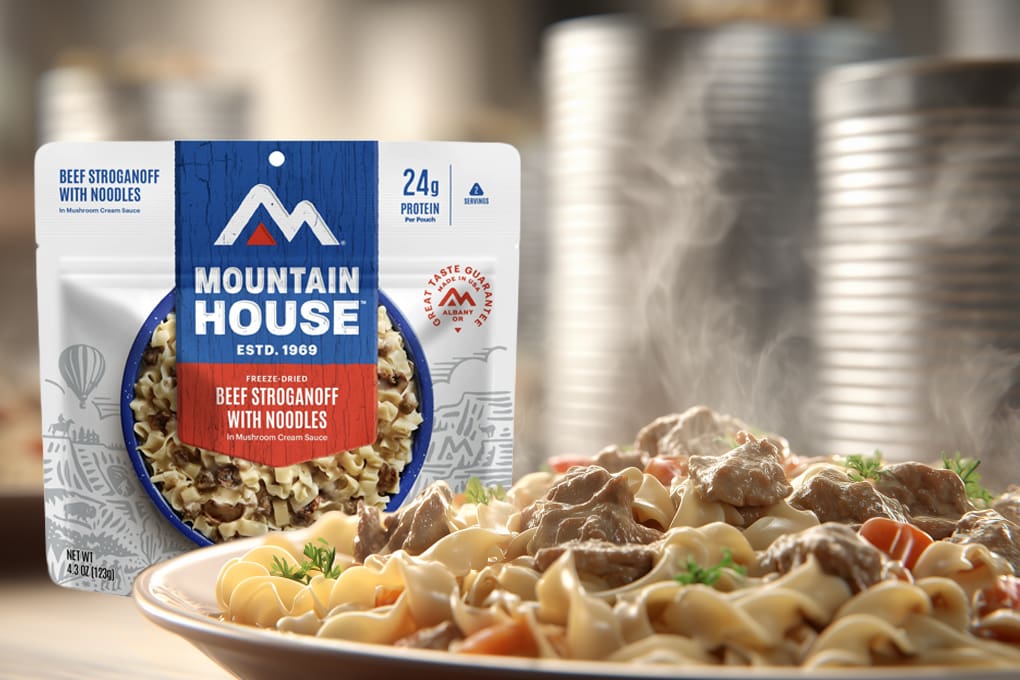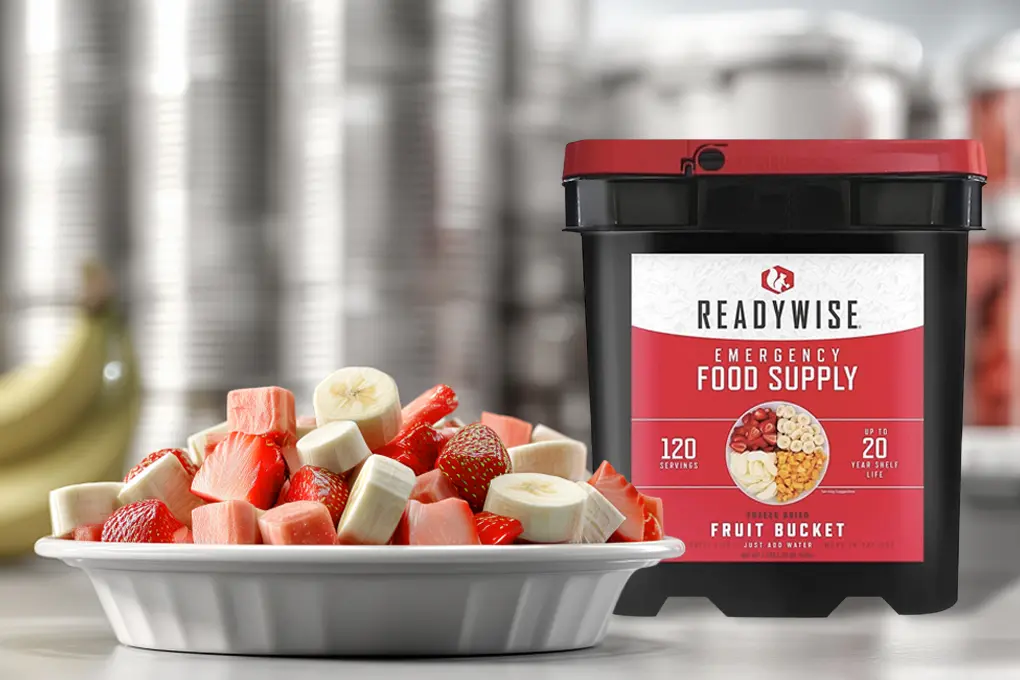Ready to build a food storage system that could last decades without spoiling? Smart preppers know that freeze-dried foods offer the perfect balance of shelf life, nutrition, and convenience when disaster strikes.
When choosing the best freeze dried food for prepping, you’re looking at options that can feed your family for years while taking up minimal storage space.
After testing dozens of brands and meal types, I’ve found that the top freeze-dried foods combine exceptional taste, proven shelf stability, and straightforward preparation that works whether you’re dealing with a power outage or a multi-week emergency.
Contents
- Key Takeaways
- Why Freeze Dried Food Is Essential for Preppers
- Top Freeze Dried Food Brands for Emergency Preparedness
- Essential Freeze Dried Foods Every Prepper Needs
- Storage and Shelf Life Considerations
- Preparation and Water Requirements
- Cost Analysis and Budget Planning
- Special Dietary Considerations
- Integrating Freeze Dried Foods with Overall Preparedness
- Testing and Rotating Your Food Storage
- Building Your Freeze Dried Food Strategy
- Making the Right Choice for Your Family
- Final Thoughts on the Best Freeze Dried Foods for Emergency Preparedness
- Frequently Asked Questions
Key Takeaways
- Freeze-dried foods retain up to 97% of nutrients, far higher than dehydrated or canned alternatives.
- Properly stored freeze-dried meals can last 25 to 30 years, compared to two to five years for canned goods.
- Top brands of freeze-dried foods include Mountain House for premium taste, ReadyWise for affordable bulk storage, Augason Farms for ingredient variety, and Valley Food Storage for clean-label options.
- Essential categories include complete meals, proteins, fruits, vegetables, dairy, rice, and pasta for balance and flexibility.
- Storage requires cool, dry, and dark conditions, with Mylar bags, buckets, or cans all performing well when protected from heat and moisture.
- Budget planning is best approached gradually, starting with 72-hour kits and expanding to multi-month supplies while accounting for dietary needs.
- Batten Emergency’s expert-curated storage solutions help you build a reliable system with confidence.
Why Freeze Dried Food Is Essential for Preppers
Freeze-dried food has become a cornerstone of modern emergency preparedness for good reason. Unlike canned goods, which typically last two to five years, properly stored freeze-dried meals can remain edible for 25 to 30 years without losing significant nutritional value. This makes them one of the most reliable long-term food storage solutions available today.
Nutritional Preservation
The freeze-drying process preserves approximately 97% of the food’s original nutrients, according to research published in PMC. On the other hand, dehydrated foods retain closer to 60%, and canned foods may retain only about 40%. This difference becomes critical during extended crises when the body relies on a steady intake of vitamins and minerals to maintain strength and stamina.
Studies consistently confirm freeze-drying’s ability to retain nutrients. For example, researchers at Sheffield Hallam University found that freeze-dried strawberries largely maintained their vitamin C and phenolic content when compared with fresh strawberries stored for seven days. Such findings highlight the process’s effectiveness at preserving both nutritional value and flavor.
Reliability During Emergencies
One of the greatest benefits of freeze-dried food is its stability during power outages. While refrigerated items spoil quickly without electricity, freeze-dried products require no refrigeration or freezing.
All that’s needed is clean water to rehydrate the food, making them dependable when infrastructure fails. Their lightweight nature also makes them ideal for bug-out bags or rapid evacuation scenarios, where portability and shelf life are equally important.
Practical Food Storage Strategies
Successful preparedness often combines both freeze-dried ingredients and complete meal pouches. Individual ingredients, such as vegetables, proteins, and grains, provide flexibility for building balanced meals and stretching supplies.
Meanwhile, full meal pouches deliver ready-to-eat options during high-stress moments when convenience is essential. This mix ensures both variety and efficiency in long-term storage plans.
Growing Need for Preparedness
Recent statistics underscore the importance of having dependable food reserves. FEMA’s 2020 preparedness survey found that only 68% of Americans had taken three or more basic preparedness actions. A Kelton Research survey reported that 85% of Americans do not feel ready for a major disaster. Even outside of emergencies, food insecurity remains an issue – research published in PMC showed that 12.7% of Americans reported not having enough food within the past week.

Top Freeze Dried Food Brands for Emergency Preparedness
When building a dependable long-term food supply, choosing the right brand makes a major difference in quality, convenience, and reliability. The following companies consistently stand out for preppers, each offering unique strengths.
Mountain House: The Gold Standard
Mountain House has built a reputation as the premium choice among preppers and backpackers. Their meals, especially the beef stroganoff, are widely praised for taste and texture that come close to freshly cooked food. Preparation is simple – just add hot water directly to the pouch, wait a few minutes, and eat without extra dishes.

The company’s decades of military and outdoor experience show in its packaging reliability and shelf life, which can extend to 30 years under proper storage. Their meat portions are generous compared to many competitors, and the consistency remains strong across different recipes. While priced higher than budget brands, the quality and convenience often justify the cost.
Best Options: Beef Stroganoff, Chicken and Rice, Breakfast Skillet
ReadyWise: Budget-Friendly Bulk Storage
ReadyWise appeals to families looking to stock up on food reserves at a lower cost per serving. Their bucket systems provide stackable, weather-resistant storage and make organizing a larger food supply straightforward.
Meals are easy to prepare by adding water, though some require slightly longer cooking times than Mountain House. Ingredient quality has improved over the years, with real meat and vegetables now included in many options.

For households storing food for four or more people, ReadyWise provides practical portion sizes and broad variety. While not known for gourmet flavor, the meals deliver dependable calories and nutrition when it matters.
Best Options: Emergency Food Supply Buckets, Freeze Dried Meat Variety Bucket
Augason Farms: Individual Ingredients Champion
Augason Farms is well-regarded for its wide range of freeze-dried ingredients sold in large #10 cans. This format is especially useful for preppers who want to cook from scratch or supplement existing meals. Their freeze-dried fruits, vegetables, and proteins can be used in recipes or eaten on their own as snacks.
One great option is their whole egg powder, which has proven valuable during shortages and reconstitutes into scrambled eggs with a taste close to fresh.

The cans stack neatly for long-term storage and include resealable lids for convenience, though opened cans should be used within a few months for best quality. For families that prefer variety and flexibility, Augason Farms provides more options than premade meals alone.
Best Options: Freeze Dried Strawberries, Whole Egg Powder, Ground Beef
Valley Food Storage: Clean Ingredients Focus
Valley Food Storage focuses on offering meals made with simple, clean ingredients. Their recipes avoid GMOs, MSG, and hydrogenated oils, making them popular with health-conscious families. The flavor profiles are straightforward and geared toward wholesome comfort foods, which can be more appealing for children or those with sensitive diets.

Meals are sold in family-sized portions, making them practical for group use during emergencies. While their prices are higher than budget brands, the ingredient quality appeals to preppers who prioritize nutrition and peace of mind. Subscription programs are available to spread costs over time and build up storage steadily.
Best Options: Family Emergency Kit, Freeze Dried Meat Bucket
Essential Freeze Dried Foods Every Prepper Needs
A strong emergency food supply should balance nutrition, convenience, and variety. Freeze-dried options make this possible by combining long shelf life with reliable flavor and flexibility. The following categories cover the essentials that belong in every prepper’s pantry.
Complete Meal Systems
Ready-to-eat meal pouches provide valuable convenience when time, energy, or cooking resources are limited. Look for meals that serve two to four portions per pouch and require less than 15 minutes of preparation.
Balanced nutrition is critical during emergencies, so prioritize options with sufficient protein, complex carbohydrates, and healthy fats to sustain higher calorie demands from stress or physical activity.
Variety is equally important. Stocking at least eight to ten different meal types helps prevent “food fatigue,” which can reduce appetite and lower overall calorie intake when consistent nutrition is most needed.
Protein Sources
Protein keeps energy levels stable and supports muscle repair, making it one of the most important staples in an emergency diet. Freeze-dried meats such as chicken, beef, and turkey supply complete amino acid profiles and remain shelf-stable for decades when stored correctly.
Ground beef is especially versatile, working in pasta, soups, or paired with rice. Chicken chunks rehydrate well and can be used in salads, casseroles, or simple skillet meals.
For families accustomed to hunting or outdoor cooking, freeze-dried meats provide a sense of normalcy and comfort by replicating familiar “real food” flavors.
Fruits and Vegetables
Freeze-dried produce helps maintain vital fiber, vitamins, and minerals. Fruits like strawberries, bananas, and apples provide natural energy and quick snacking options without preparation. This is particularly valuable when fuel conservation limits cooking.
Vegetables such as peas, carrots, and green beans add both nutrition and variety to simple dishes like rice or pasta. Having familiar flavors and textures helps sustain morale and keeps meals balanced during extended emergencies.
Dairy and Staples
Dairy-based staples expand cooking options and provide essential nutrients. Powdered milk, cheese, and whole egg powder add calcium, protein, and versatility for baking or meal preparation.
Egg powder reconstitutes effectively for breakfast dishes or use in recipes, while butter powder improves flavor and adds comfort during stressful times.
Base ingredients like rice and pasta pair well with freeze-dried proteins and vegetables, offering caloric density and meal flexibility. Storing these staples alongside freeze-dried foods ensures you can create balanced, filling meals rather than relying solely on pre-packaged options.
Storage and Shelf Life Considerations
The quality and longevity of freeze-dried foods depend heavily on how they are stored. Temperature, humidity, light exposure, and packaging all play critical roles in preserving both nutrition and flavor.
Temperature Control
Consistent cool temperatures are the most important factor in extending shelf life. Storage areas should remain between 50°F and 70°F with as little fluctuation as possible.
Research confirms that lower storage temperatures slow chemical changes in dried foods. While standard dehydrated products may only keep well for about a year under 60°F, properly stored freeze-dried foods can remain stable for decades.
Humidity Management
Humidity is the second major concern. Excess moisture quickly compromises food safety by encouraging microbial growth or spoiling packaging. Basements work well if they stay dry, but avoid areas prone to condensation or flooding. Storing foods in Mylar bags with oxygen absorbers inside sealed buckets provides excellent protection, particularly for opened packages.
Light Exposure
Prolonged light exposure weakens packaging and degrades food quality. To avoid this, keep freeze-dried foods in dark locations, opaque containers, or secondary storage bins. Using a first-in, first-out rotation system ensures you consume older stock first, though rotation is less critical with foods that have a 25- to 30-year unopened shelf life.
Long-Term Storage Lessons
Experienced preppers consistently report that the storage environment matters more than the container itself. Freeze-dried food stored in buckets, #10 cans, or Mylar bags all perform well when conditions remain cool, dry, and dark. Most high-quality products maintain peak taste and nutrition for 25 to 30 years unopened. Once opened, they are best used within one to two years, though they typically remain safe beyond that window.
Preparation and Water Requirements
Rehydration is straightforward, but planning for water use and heat sources is important. Most freeze-dried meals require one to two cups of water per serving, with preparation times averaging 10 to 20 minutes.
Water Temperature
Hot water speeds up rehydration and improves texture, while cold water can be used in situations where heating is not possible. Expect longer preparation times when using cold water. Having backup heating options such as camp stoves, wood-burning stoves, or solar cookers is invaluable during power outages.
Water Safety
The quality of your water directly impacts both taste and safety. Always store additional water purification supplies alongside your food storage. Filters, purification tablets, or boiling methods help ensure that rehydrated meals remain safe to consume even if local water supplies are compromised.
Preparation Tips
A practical approach is to let meals sit for five to ten minutes longer than package directions suggest, especially for rice or pasta-based dishes. Stirring halfway through the rehydration process helps distribute moisture evenly and creates a more satisfying texture.
Cost Analysis and Budget Planning
Freeze-dried food represents a higher upfront cost than everyday groceries, but its long shelf life and convenience make it a valuable investment for preparedness. On average, quality products range from $8 to $15 per serving.
While this is more expensive than cooking from scratch, it is often less than a restaurant meal and provides the assurance of long-term stability.
Budget planning works best when approached at the family level. Instead of pricing meals individually, calculate needs based on how many servings your household requires over time. Bulk purchases and ingredient-focused storage reduce per-serving costs. Pairing freeze-dried foods with inexpensive staples such as rice, pasta, oats, and beans stretches supplies further while maintaining nutrition.
It is often useful to think of food storage as insurance. The peace of mind gained from having three to six months of shelf-stable meals ready offsets the initial investment for most families.
Building storage gradually is also more manageable than buying everything at once. Start with a 72-hour supply, expand to two weeks, and then extend to monthly and seasonal supplies as your budget allows.
FEMA and the American Red Cross recommend at least several days of non-perishable food for every household member. Yet surveys show that 40%of Americans report being unable to stock certain supplies due to cost, and 27% say they do not know where to start. This gap highlights the importance of both planning and incremental investment.
Special Dietary Considerations
Every household has unique nutritional needs, and freeze-dried food manufacturers are increasingly addressing these requirements. Preppers should plan carefully for restrictions or health conditions to ensure the food supply remains practical and safe.

Allergen-Friendly and Organic Options
Many brands now provide gluten-free, dairy-free, and organic choices. ReadyWise and Peak Refuel are known for clearly labeling meals that are free from common allergens, which simplifies selection for families managing sensitivities.
Health Conditions and Nutritional Balance
For families with diabetic members, choose meals with controlled carbohydrates and higher protein and fiber content to maintain blood sugar stability.
Sodium content is another important factor, as many freeze-dried meals contain elevated levels for preservation. Those with hypertension should prioritize low-sodium options or balance intake with fresh or low-sodium stored foods.
Vegetarian and Vegan Options
While meat-based meals dominate the market, some companies, such as Valley Food Storage, provide plant-based proteins. Combining freeze-dried vegetables with stored grains and legumes creates a complete amino acid profile, ensuring balanced nutrition for vegetarian or vegan diets.
Kid-Friendly Meals
Children typically respond well to freeze-dried foods when flavors are familiar. Options such as mac and cheese, chicken noodle soup, or fruit snacks help maintain normal eating routines during stressful events. Including a mix of adult-oriented and child-friendly meals ensures the entire family has food they will actually eat when it matters most.
Integrating Freeze Dried Foods with Overall Preparedness
Freeze-dried foods are most effective when incorporated into a broader preparedness plan. They provide long-term reliability but should be balanced with other storage methods for flexibility and resilience.
Pairing freeze-dried meals with home-canned goods, dehydrated items, and everyday pantry staples creates a layered system that adapts to different emergencies. For instance, canned goods are convenient for short outages, while freeze-dried meals excel during prolonged disruptions when fresh supplies are limited.
Distributing storage across multiple locations adds an extra layer of security. Instead of keeping all supplies in one area, divide them between pantries, basements, or even outbuildings. This protects against localized damage and ensures access if certain areas become inaccessible.
Finally, safe food preparation must be part of the plan. Store thermometers, water filters, and sanitation supplies alongside your food to maintain safety standards during crises. Clean water, proper heating methods, and hygiene practices are essential for turning stored food into safe, reliable meals.
Testing and Rotating Your Food Storage
A food supply is only reliable if you know how it performs. Regular testing and rotation ensure both quality and family acceptance.
Taste Testing and Familiarity
Preparing freeze-dried meals every few months gives you valuable practice with cooking times, water use, and portion sizes. It also helps identify which meals your family enjoys. Children, in particular, adjust better if they have tried the foods before an actual emergency. Testing ahead of time avoids the challenge of unfamiliar flavors during stressful situations.
Documentation and Tracking
Keeping notes on which meals are well-received helps guide future purchases and reduces waste. For families committed to long-term storage, detailed logs of purchase dates, expiration ranges, and storage conditions can be useful. While freeze-dried foods are safe for decades if stored correctly, record-keeping makes it easier to rotate stock and plan replacement schedules efficiently.
Building Your Freeze Dried Food Strategy
Developing a storage plan works best when you expand in stages. Begin with a short-term supply, then build toward longer-term security as you refine your system.
Establishing a Foundation
Start with at least a 72-hour supply for each family member, prioritizing complete meals that require minimal preparation. This foundation covers immediate emergencies while providing flexibility to scale up.
Expanding for Long-Term Use
Gradually add individual ingredients and specialty items based on cooking skills and dietary needs. Aim for a balance between convenient ready-made meals and ingredients that allow for variety. A reliable target is 2,000 to 2,500 calories per person per day, adjusted for age, activity level, and stress-related calorie increases.
Seasonal Adjustments
Factor in seasonal needs. During winter, higher-calorie meals and comfort foods may be more appropriate, while in summer, lighter meals and hydrating options can help with heat stress. Planning around seasonal conditions ensures your storage remains practical year-round.
Making the Right Choice for Your Family

No single brand or method suits every household. Your choices should reflect your family’s budget, storage capacity, and cooking comfort level.
Balancing Brand Options
Mountain House is often praised for quality and taste, though it comes at a higher price. ReadyWise provides affordable bulk storage that suits larger families. Valley Food Storage appeals to those prioritizing clean ingredients, while Augason Farms is a go-to for bulk ingredients.
Combining Meals and Ingredients
Families new to prepping benefit from a mixed approach: a selection of ready-to-eat meals for convenience, along with basic ingredients for cooking flexibility. This combination ensures both immediate usability and long-term adaptability.
Matching Skills and Equipment
Consider your cooking experience and emergency gear. Families with limited equipment or cooking skills may find ready-made meals more practical, while experienced cooks may prefer ingredient-based storage for variety.
Choosing Foods Your Family Will Eat
Above all, prioritize foods that your household will actually consume. Stocking only unfamiliar or unappealing meals risks wasted storage. Familiarity improves morale and ensures everyone gets adequate nutrition during stressful periods.
For complete emergency preparedness, food storage should be paired with water reserves, shelter supplies, communication tools, and safety equipment. When comparing brands and flavors, consult our survival food taste testing guide and in-depth reviews, such as our Nutrient Survival review, to make informed decisions that fit your household’s needs.
For more comprehensive emergency preparedness guidance, explore our emergency kit essentials to ensure you’re ready for any situation.
Final Thoughts on the Best Freeze Dried Foods for Emergency Preparedness
Freeze-dried food has proven itself as one of the most dependable tools for long-term emergency preparedness. With shelf lives reaching 25 to 30 years, high nutritional retention, and simple preparation, it provides peace of mind during both short-term disruptions and prolonged crises.
From complete meal pouches to versatile individual ingredients, the right mix ensures your family has reliable options that balance convenience and nutrition. Careful storage, budget planning, and rotation make these foods practical and cost-effective over time.
By considering dietary needs, cooking skills, and storage space, you can design a system that keeps your household resilient when it matters most. With trusted brands and expert-tested products, building a reliable food supply has never been easier.
Want to build your family’s emergency preparedness without the guesswork? Explore Batten Emergency’s expert-vetted food storage solutions and discover the peace of mind that comes with proper preparation.
Frequently Asked Questions
How Does Freeze Dried Food Compare to Dehydrated Food for Prepping?
For freeze dried food prepping, the biggest advantage is longevity. Freeze dried emergency food can last 25 to 30 years, while dehydrated food usually tops out at five to ten. Freeze dried survival food also retains up to 97% of nutrients, compared to about 60% for dehydrated items. For the best prepper food supply, most experts recommend combining both, but the best freeze dried food for survival is more dependable in long-term emergencies.
What Is the Best Way to Choose Prepper Food for Long-Term Storage?
The best prepper food should provide balanced calories, nutrients, and ease of use. Emergency food kits are excellent for beginners since they include complete meals ready to store. The best freeze dried food for prepping includes both meal pouches and single-ingredient staples.
Reading survival food reviews helps identify the best survival meals for your family, focusing on taste, preparation time, and nutrition. Choosing wisely prevents waste and ensures your emergency food and supplies work for everyone.
How Much Freeze Dried Survival Food Should a Household Store?
A strong guideline is 2,000 to 2,500 calories per person per day. Start with 72-hour emergency food kits, then expand to weeks or months. The best freeze dried food for survival includes calorie-dense proteins, grains, and vegetables to meet higher stress-related needs.
Many families aim for three to six months of freeze dried survival food. This staged approach ensures you always have the best freeze-dried food for emergency use when disruptions last longer than expected.
What Are the Best Survival Meals for Children and Picky Eaters?
The best survival meals for kids are those that mirror everyday comfort foods. Options like mac and cheese, chicken noodle soup, and fruit-based snacks consistently rank well in survival food reviews.
Families report better acceptance when freeze dried emergency food tastes familiar. Including kid-friendly options in your best prepper food supply helps children eat consistently during stressful times. For long-term comfort, balance adult-focused meals with these choices to maintain both morale and nutrition.
Are Emergency Food Kits Enough on Their Own?
Emergency food kits are a solid foundation, but they work best when paired with other supplies. While the best freeze-dried food for emergency use provides convenience, variety matters in longer disruptions.
Adding canned goods, grains, and home-preserved foods ensures dietary balance. The best freeze dried food for prepping works well as a core supply, but combining it with other emergency food and supplies creates a layered system. This approach gives families options for different scenarios.
Where Can I Find Reliable Survival Food Reviews Before Buying?
A detailed survival food review is one of the best ways to avoid wasting money on poor-tasting or unreliable meals. Trusted prepper food resources such as Batten Emergency and specialty preparedness blogs publish survival food reviews that test taste, ease of use, and shelf life.
These reviews often compare the best freeze-dried food for prepping, including Mountain House, ReadyWise, and Valley Food Storage. Reading survival food reviews ensures you pick the best survival food for your needs.
What Is the Best Freeze Dried Food for Prepping on a Budget?
The best freeze dried food for prepping on a budget usually comes from bulk emergency food kits. ReadyWise, Augason Farms, and similar brands offer the best dried food for survival at lower cost per serving.
Combining these with inexpensive staples such as rice or beans reduces costs while maintaining calories. For many households, the best freeze dried food for emergency storage balances affordability with shelf life, ensuring both value and security without overspending.
How Do I Balance Freeze Dried Survival Food with Fresh or Canned Foods?
Freeze dried survival food provides unmatched longevity, but variety is key to maintaining a healthy diet. Canned foods are ideal for shorter emergencies, while freeze dried emergency food excels in long-term scenarios.
The best freeze dried food for survival pairs well with pantry staples like rice and pasta. Including both options prevents menu fatigue. For the best prepper food supply, use emergency food kits for convenience while stocking individual ingredients for flexibility in recipes.
What Is the Best Freeze Dried Food for Survival in Harsh Conditions?
The best freeze dried food for survival in harsh conditions should be lightweight, calorie-dense, and easy to prepare.
Backpackers and preppers alike rate Mountain House and Peak Refuel highly in survival food reviews for performance under rugged conditions.
The best freeze-dried food for emergency use also rehydrates quickly with minimal water, making it suitable when fuel and clean water are limited. For the best survival food system, prioritize options tested in real-world outdoor use.
Sources
- Freeze-Drying of Plant-Based Foods – PMC
- Study highlights freeze drying benefits – Food and Drink Technology
- FEMA Publishes Annual Preparedness Survey: Trends Show Americans Becoming Better Prepared | FEMA.gov
- How Prepared are Americans? – Ready Store
- Comparison of Emergency Preparedness Practices between Food Assistance Program Participants and Non-Participants in the United States – PMC
- Shelf life of Freeze Dried and Dehydrated Food – Food Assets
- The Freeze-Drying of Foods—The Characteristic of the Process Course and the Effect of Its Parameters on the Physical Properties of Food Materials – PMC




